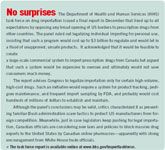Side Effects
Pharmaceutical Executive
One response to today's safety concerns is particularly alarming: The research community has become skittish about conducting clinical studies involving pain medications and other high-risk treatments.
Drug safety has become the issue for pharma, its regulators, and its critics. The past few weeks have seen the issue receiving a new level of attention in almost every area of drug development, regulation, and marketing. The latest round of events—from dropped research projects to new regulatory proposals—show just how pervasive safety worries are likely to become in the months to come.

Jill Wechsler
Raising the Bar
One response to today's safety concerns is particularly alarming: The research community has become skittish about clinical studies that involve pain medications and other high-risk treatments. In December, researchers halted an important NIH-sponsored study to test whether COX-2 inhibitors might help prevent colon cancer. The study was killed when data from more than 2,000 patients indicated that those taking Pfizer's Celebrex (celecoxib) were experiencing more cardiovascular events.
A few days later, NIH halted a study testing whether naproxen (Bayer's Aleve) or Celebrex might help delay the onset of Alzheimer's disease in high-risk individuals. This time the researchers found cardiac risks in patients taking naproxen—but not Celebrex. Despite the mixed safety signals, investigators also put a hold on additional NIH cancer trials seeking evidence of additional uses for commonly prescribed painkillers. Some 40 studies testing Celebrex for various purposes are currently under review. Pfizer believes the data are inconclusive about safety and may yet reveal anti-cancer benefits. Pfizer is keeping Celebrex on the market pending review—but will comply with an FDA request to halt direct to consumer advertising for Celebrex and to provide more risk information to doctors pending further safety evaluation.

No surprises
The panel that conducted the review acknowledge that the bad news about COX-2 safety problems led them to examine the adverse event data from these trials earlier than planned. Some cancer trials use doses much higher than those recommended for arthritis patients, which may have led to higher rates of side effects. But more than 20 million people have used these therapies, and the reviewers felt they had to be exceptionally cautious. FDA plans to address COX-2 issues at a meeting of its drug safety advisory committee late this month and is working with the Institute of Medicine (IOM) on a broader assessment of the agency's safety review activities. (see "Making Medical Errors Rare," )
More Comparisons
Another response to drug safety problems has been to urge more head-to-head comparison of similar medicines. The Medicare bill authorized the HHS Agency for Healthcare Research & Quality (AHRQ) to support more research on comparative effectiveness of medical interventions—explicitly including prescription drugs—for the top 10 conditions affecting the elderly. AHRQ's 2005 budget contains $15 million for this initiative—much less than the $50 million initially proposed, but enough to get the program started.
In December AHRQ issued a long-awaited list of priority conditions warranting comparative study: ischemic heart disease, cancer, asthma, stroke, arthritis, diabetes, dementia, pneumonia, stomach ulcers, and depression. AHRQ will start by funding projects to review the scientific literature on outcomes of various treatments for these conditions. The aim is to help physicians and patients make informed treatment choices by communicating the results to Medicare, Medicaid, health plans, prescription drug plans, and the public. AHRQ is not supposed to set national standards of care, but its analysis is likely to lead to increased agreement on the relative effectiveness of certain interventions.
Manufacturers stress that any comparative drug analysis should focus more on effectiveness than on costs. In addition, it should include drugs among a full range of treatment options and recognize that patients respond differently to various treatments and products. Industry has long opposed any move by FDA to require clinical studies of new versus existing drugs in order to bring a new drug to market, as noted in a PhRMA (Pharmaceutical Research and Manufacturers of America) white paper on government-supported outcomes research issued a year ago in anticipation of increased involvement in this area by AHRQ and NIH. A main concern is that comparative studies could block some less effective products from coming to market, even when those drugs offer benefits for certain patients.
Meanwhile, private insurers and payers are supporting more comparative studies, as seen in the growth of the Drug Effectiveness Review Project operated by Oregon's Center for Evidence-based Policy Support. The project is providing 12 states and other organizations with head-to-head comparisons of drugs that treat common conditions such as diabetes, migraine, and elevated cholesterol. The objective is to help health plans select the most effective, cost-effective drugs for formularies, but in today's climate, analysts are paying close attention to safety as well.
Fixing FDA
The safety issue is contributing to the clamor to revamp FDA drug regulation. Many old proposals are back on the table after languishing due to a lack of funding. Now Congress may be more willing to ante up the money to expand post-approval monitoring and other initiatives. Look for proposals to:
Strengthen FDA authority to limit product distribution, curb marketing, and enforce safety requirements as alternatives to pulling a risky drug off the market completely. The aim is to give FDA more clout to compel companies to expand label warnings and to revise misleading advertising.
Establish an independent drug safety office. A major debate is expected over proposals to separate the review of safety and efficacy data and to give safety officers veto power over risky new drug applications. Manufacturers and many FDA officials believe it is important to consider safety and efficacy data together to fully evaluate risks and benefits, and FDA is proposing internal changes designed to avoid a major reorganization.
Switch to a "conditional approval" system with a regular schedule to reassess safety and efficacy data in order for a drug to remain on the market.
Expand post-marketing study requirements. All parties acknowledge that many drug effects emerge only after many thousands, even millions, of patients have used a medicine for many months. Thus, there is support for giving FDA more authority to compel manufacturers to conduct post-approval studies.
Require clinical trial registration and study disclosure. Manufacturers are expanding data posting activities voluntarily, but some members of Congress believe that mandated disclosure is needed to ensure that all important safety information reaches prescribers and patients. (For more information, see "See-Through Research".)
Improve FDA's adverse event reporting system to capture and analyze adverse drug event reports more quickly and more effectively. FDA needs additional resources to conduct more prospective safety analyses and to utilize health system databases that collect information on a broad range of drug effects. The new Medicare drug benefit could provide HHS with a gold mine of drug prescribing and utilization data on a fairly vulnerable patient population, which may enhance FDA post-marketing capabilities considerably.
Curb DTC advertising and other marketing activities, particularly for new products and those that raise safety concerns. Critics claim heavy advertising and the resulting inappropriate prescribing of Vioxx and Celebrex turned drugs designed for fairly targeted patient populations into blockbusters, creating serious health problems and boosting healthcare spending.
Jill Wechsler is Pharmaceutical Executive's Washingtoncorrespondent.
Pfizer, GSK Gain ACIP Recommendations for RSV and Meningococcal Vaccines
April 18th 2025The Centers for Disease Control and Prevention’s Advisory Committee on Immunization Practices voted to expand access to Pfizer’s respiratory syncytial virus vaccine Abrysvo for high-risk adults in their 50s and voted in favor of GSK’s meningococcal vaccine, Penmenvy, for streamlined adolescent protection.
Navigating Distrust: Pharma in the Age of Social Media
February 18th 2025Ian Baer, Founder and CEO of Sooth, discusses how the growing distrust in social media will impact industry marketing strategies and the relationships between pharmaceutical companies and the patients they aim to serve. He also explains dark social, how to combat misinformation, closing the trust gap, and more.
